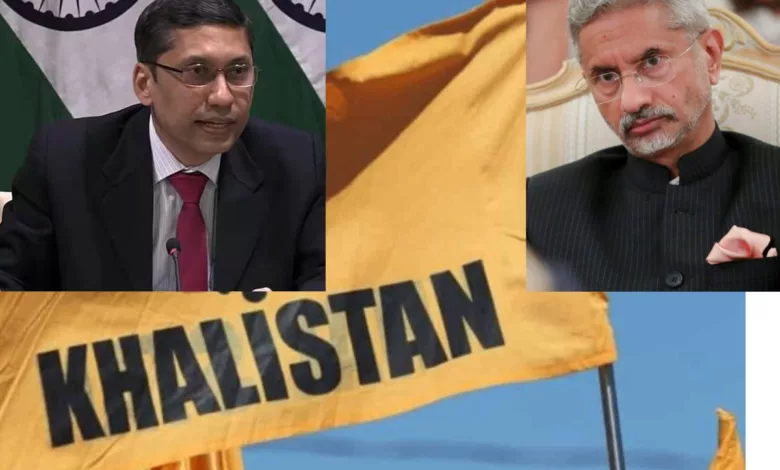Attacks On Indian Communities In Foreign Lands.
The pro-Khalistan organizations started to work independently together towards the objective, which is to attack the property, offices, and temples of the Indian government.

In response to Khalistanis’ attacks on Indian missions abroad, the Ministry of External Affairs stated that India would prefer to see action rather than only assurances, and he hoped that other governments will take appropriate legal action and hold those responsible accountable.
During the weekly media briefing, a question regarding the vandalism of the Indian High Commission in London and the Indian High Consulate in San Francisco was raised. In response, MEA spokesperson Arindam Bagchi stated that whenever India feels there is a problem involving the safety of our missions abroad, high commissions, and embassies, this concern is taken up. They do raise issues if there are concerns about potential attacks that may jeopardize the interests.
One could see that India has taken the issue of attacks and vandalism against their missions overseas very seriously, especially in London and, at least, in San Francisco. He said one would have noticed India’s remarks in this respect.
Bagchi went on to say that India wants the host governments to take action to find and prosecute everyone responsible and to take the necessary steps to avoid similar instances from happening in the future. Moreover, he hoped that the government would fully and adequately safeguard the staff members working in Indian missions.

Incidence form March 19.
A pro-Khalistan protester had earlier scaled the balcony of the Indian High Commission in London and removed the country’s flag. On social media, a video of the same occurrence gained a lot of attention. The Khalistani protester can be seen on the balcony in the now-viral footage attempting to lower the Indian flag. Towards the conclusion of the film, another man can be seen climbing the balcony and taking the Tricolor away from the supporter of Khalistan.
Advocates of Khalistan have also been accused of assaulting the Indian Consulate in San Francisco (SFO), as seen by videos of fans bashing doors and invading the office.
Despite images of the attacks at the San Francisco embassy circulated on social media, Indian officials have not officially acknowledged the occurrence.
The consulate was the scene of the event, as witnessed by the images, although the day was not known. Images posted online depict a sizable throng smashing the embassy building’s glass doors and windows while waving Khalistan flags atop wooden rods. They shouted pro-Khalistan cries, scaled temporary security barricades put up by the municipal police, and placed two Khalistani flags inside the building.

Incidence from March 25.
The Ministry of Foreign Affairs summoned the Canadian High Commissioner due to a security violation at the Indian embassy in Ottawa. The MEA claimed that the summons had been issued to express its deep concern regarding the last week’s attacks on the diplomatic missions and Consulates in Canada by separatist and extremist elements. India’s foreign ministry also requested an explanation of how such people were permitted, in the presence of police, to violate the security of the diplomatic missions and Consulates.
This comes after India summoned senior diplomats from the United Kingdom and the United States of America to protest against vandalism at its High Commission in London by a group of anti-India clan chanting pro-Khalistan slogans, and an equivalent turbulent scenario witnessed in the land of San Francisco.
Incidence from February.
Earlier, according to media sources, members of the Khalistan movement in Australia attacked the Indian Consulate in Queensland’s city of Brisbane in February and flew their flag at the office. These attacks on the Consulate come only a few days after Indian Foreign Affairs Minister S Jaishankar visited Australia and urged Australians to be wary of “radical” candidates who target the Indian community in Australia.
India has previously asked the Australian government to intervene to prevent more anti-Indian acts by Khalistan separatists involving attacks on Hindu temples within the continent.

The angry attitude of the Indian government was a result of attacks on foreign lands.
The pro-Khalistan organizations started to work independently together towards the objective, which is to vandalize the property, offices, and temples of the Indian government. Regrettably, the local authorities in these locations neglected to provide security for diplomatic personnel and missions, necessitating reactions from New Delhi.
The security barriers put up in the vicinity of the home of the British High Commissioner in New Delhi were dismantled. This is a response to the attack and destruction at the Indian High Commission in London. By taking down the barriers, New Delhi is making it clear to 10 Downing Street that it intends to take the attacks on Indian embassies abroad seriously.
It is a strong and unequivocal warning to the concerned foreign countries to take the security of Indian embassies seriously. The withdrawal of security from important areas in the national capital also informs anxious elements of the population that the administration is capable of responding if necessary.
The conclusion.
New Delhi would have to raise the issue with international countries at the highest levels. Some foreign countries may be compelled by political considerations to accept anti-India groups. However, they ought to be brought to the attention of the red lines if they are inclined to become part of the anti-India narrative, even by maintaining silence and denying to support such conduct.
Edited by Prakriti Arora




